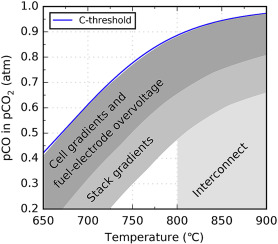Journal of Power Sources ( IF 8.1 ) Pub Date : 2017-11-07 , DOI: 10.1016/j.jpowsour.2017.10.097 Theis Løye Skafte , Peter Blennow , Johan Hjelm , Christopher Graves

|
Reduction of CO2 to CO and O2 in the solid oxide electrolysis cell (SOEC) has the potential to play a crucial role in closing the CO2 loop. Carbon deposition in nickel-based cells is however fatal and must be considered during CO2 electrolysis. Here, the effect of operating parameters is investigated systematically using simple current-potential experiments. Due to variations of local conditions, it is shown that higher current density and lower fuel electrode porosity will cause local carbon formation at the electrochemical reaction sites despite operating with a CO outlet concentration outside the thermodynamic carbon formation region. Attempts at mitigating the issue by coating the composite nickel/yttria-stabilized zirconia electrode with carbon-inhibiting nanoparticles and by sulfur passivation proved unsuccessful. Increasing the fuel electrode porosity is shown to mitigate the problem, but only to a certain extent. This work shows that a typical SOEC stack converting CO2 to CO and O2 is limited to as little as 15–45% conversion due to risk of carbon formation. Furthermore, cells operated in CO2-electrolysis mode are poisoned by reactant gases containing ppb-levels of sulfur, in contrast to ppm-levels for operation in fuel cell mode.
中文翻译:

镍基固体氧化物电池电极中CO 2电解过程中的碳沉积和硫中毒
在固体氧化物电解槽(SOEC)中将CO 2还原为CO和O 2可能在关闭CO 2回路中起关键作用。但是,镍基电池中的碳沉积是致命的,必须在CO 2期间加以考虑电解。在这里,使用简单的电流电势实验系统地研究了运行参数的影响。由于局部条件的变化,显示出较高的电流密度和较低的燃料电极孔隙率将导致尽管在热力学碳形成区域之外以CO出口浓度进行操作也可在电化学反应位置处引起局部碳形成。通过用抑制碳的纳米颗粒涂覆复合镍/氧化钇稳定的氧化锆电极并通过硫钝化来缓解这种问题的尝试均未成功。示出了增加燃料电极的孔隙率可以缓解该问题,但是仅在一定程度上可以缓解该问题。这项工作表明,典型的SOEC烟囱将CO 2转化为CO和O 2由于形成碳的风险,转化率限制在15%至45%之内。此外,与在燃料电池模式下操作的ppm水平相反,在CO 2电解模式下操作的电池被包含ppb级硫的反应气体中毒。











































 京公网安备 11010802027423号
京公网安备 11010802027423号